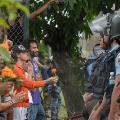
A mass student strike has shut down university campuses for nearly two months in Puerto Rico.
Students have responded to the effects of cuts to the financial support they receive from the education budget with effective mass pickets of universities. The movement has been supported with a general strike involving hundreds of thousands of public sector workers on 23 May.
Puerto Rico’s public debt of $46.7 million and budget deficit of $3.3 billion has led to demands from the US government for austerity measures totalling 30,000 job losses in the public sector and savage cuts in spending.
Puerto Rico’s governor Luis Fortuno, affiliated to the Republican party in the US, is only too happy to oblige.
The cuts to the education budget mean poorer students who receive both a tuition fee waiver (awarded to talented youth from poverty stricken backgrounds) and a financial aid grant will now face the choice of claiming one or the other as the subsidy for both grants is slashed.
Resistance
Student demonstration in San Juan. Photo by Mariana Muñiz from Desde Adentro. Republished under a CC License.
The student strikes come after a mass general strike in October 2009 shortly after the austerity package was announced. Workers in the private and public sectors and many youth, shut down highways, shopping centres and docks in the capital San Juan.
After seeing the resistance of workers, Fortuno targeted students by threatening to hike up tuition fees.
He hoped to isolate them from struggles of workers believing they would provide softer opposition to cuts. However, this has provoked the united opposition of students and workers and the whole of society.
The reaction of the governor and campus authorities to the shutdown of the universities has been brutal. University staff have been sacked for supporting the strikes and the university authorities have used court injunctions against leading student activists.
As the strike developed, thousands of riot police were deployed to surround campuses. The students’ families who have tried to climb over campus fences to get food and water to striking students have been beaten and pepper sprayed by police who made many arrests.
In response, the organisation of the students has been strong with 24-hour pickets of the campuses that have shut down the universities for nearly two months. They have set up a radio station that broadcasts across Puerto Rico which gives regular updates of strikes and protests.
University staff have also given practical support to the picketing and took strike action on 14 May. The largest job losses in the public sector, once budget cuts are made, are expected to be in education.
The students have mass support amongst the wider population which has resulted in the riot police being reined in and removed from some campuses on 19 May after support for the governor slumped in the polls.
Now with successful strikes and protests on 23 May the momentum is with the students. Whether or not the trade unions call more strikes will be decisive in disrupting the cuts and job losses. If these austerity measures are forced through, unemployment will rise to 20%.
The demands of the students at this stage focus on fighting the cuts to grants and financial support but this takes place against the backdrop of developing mass anger in Puerto Rican society.
The political establishment is seen as rotten and colonial. Puerto Rico is still under the sovereignty of the US and has limited autonomy. Economic policy is dictated by Wall Street and the profits of pharmaceutical multinationals, the largest private sector employers.
Puerto Rico, and its large diaspora in US cities, is used by US capitalism as a source of cheap labour.
Future
The developing struggles of students and workers reflect a level of radicalisation in Puerto Rico that has been compared to movements in the universities, workplaces and urban slums that took place in the 1960s – inspired by revolutionary events in France and the Cuban revolution.
But this movement in reaction to the world capitalist crisis, and its effects in the USA, will have deeper consequences – with the working class and young people playing a decisive role.
It’s likely that workers, students and youth will look to more radical ideas and socialism.
The Rio Piedras campus where the student strike began has a history of radicalism and socialism going back to the 1940s and this has been celebrated in the students’ leaflets.
Special financial appeal to all readers of socialistworld.net |
Support building alternative socialist media Socialistworld.net provides a unique analysis and perspective of world events. Socialistworld.net also plays a crucial role in building the struggle for socialism across all continents. Capitalism has failed! Assist us to build the fight-back and prepare for the stormy period of class struggles ahead. Please make a donation to help us reach more readers and to widen our socialist campaigning work across the world. |
Donate via Paypal |
| M | T | W | T | F | S | S |
|---|---|---|---|---|---|---|
| 1 | 2 | |||||
| 3 | 4 | 5 | 6 | 7 | 8 | 9 |
| 10 | 11 | 12 | 13 | 14 | 15 | 16 |
| 17 | 18 | 19 | 20 | 21 | 22 | 23 |
| 24 | 25 | 26 | 27 | 28 | 29 | 30 |
| 31 | ||||||


Be the first to comment